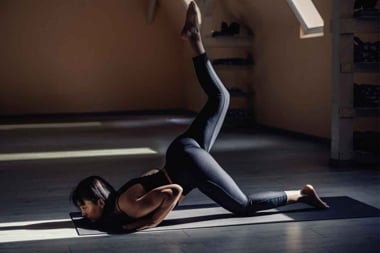The Exercise Ball

0
The first time I attended an exercise ball class–working out with a large 65-centimetre vinyl, air-filled ball–it was at my local YWCA. Memories, they say, have a certain texture and can reoccur to us in a split second. In two seconds of ball work I was reliving the hair-in-my-face frolicking quality of childhood. Except I was in my 40s!
Lying horizontal on a mat, one does not fight gravity. Here I was rolling and balancing, stretching and lunging, even tossing the ball high into the air and catching it between my feet like a circus performer. Wow!
It was only when I began to teach ball classes to non-athletic, sedentary adults that I fully appreciated how miraculous the seduction of the exercise ball is. These aging boomers, some who had not set foot in a gym for years, were committed to gleefully crawling out on their hands and knees, the ball resting in front of their knee caps and performing a series of pushups enthusiastically. Failed exercise attempts from the past were forgiven as they rediscovered how to move, stretch, dance and play with the whole body. Some revelled in the de-stressing effects of the ball.
"I love my ball," said one woman in her late 50s. "It’s my preventative medicine."
Nicknamed the "Swiss Ball" by North American therapists who saw the balls in action in the 1960s in Switzerland, these large, brightly-colored balls were first used in Europe for the treatment of orthopedic problems, somatic awareness and pediatric neuro development. Today the exercise ball is somersaulting into the fitness scene as personal trainers, coaches and physical education teachers all over North America have taken what looks like a sturdy, oversized beach ball out of the physiotherapy setting and into the gym, studio or home.
Ed McNeely, the man who created the fitness regime for the gold-medal winning Olympic rowing team, recently told Globe and Mail associate sports editor Patricia Young that the Swiss ball was his workout of choice.
"With a Swiss ball you are working stabilizing muscles and working deeper layers of muscles and using them in a way that is much more functional," he says.
At the same time as strengthening and aligning the body, the ball heightens proprioception–the awareness of how your body moves in space. By increasing the speed of the workout, or narrowing the base of support, more challenge is added. This is how the exercise ball challenges elite athletes to kick, swing, throw and jump with more control and power.
Have a Ball
In the case of an ordinary person, even one who goes kicking and screaming to a modern, repetitious get-fit class, the ball may be the solution to their exercise woes by adding variety, fun and resistance to any mat exercise. Resistance and weight bearing are crucial to strengthening muscles and preventing bone loss. The ball is also fantastic for stretching, because it provides a comfortable but firm surface that supports the user as she moves in and out of the stretch.
Even sitting on the ball is highly beneficial. The postural muscles, which are close to the vertebral column, maintain an erect spine. Bad posture and slouching behind computers or at the wheels of cars rounds the back, compresses the lungs and weakens deep spinal muscles. Sitting for periods of time on the ball retrains postural muscles. Strengthening these small muscles will help to support the larger muscles and bring the spine and body back into balance. The abdominal muscles work too–if you slouch on the ball or let go of your abs, the ball will drift and let you know!
Another dose of fun, preventive medicine is bouncing on your ball. According to physical therapist and Swiss ball pioneer Joanne Posner-Mayer, you can bounce as vigorously as is comfortable: "the gentle compression and distraction caused by bouncing aligns the spine in its most efficient position."
Many moves can be added to the bounce to create a safe cardiovascular workout which will protect your heart and the capacity of your lungs. Jumping jacks, shoulder shrugs and many arm and leg movements seen in an aerobic class can be transferred onto your ball. The ball cushions your body as your breathing deepens and calories burn. Make up your own moves but remember to never bend, twist or rotate the spine while bouncing.
Are you a still daunted by the prospect of pitting your gravity-bound body against a mobile piece of equipment that changes from second to second and never reacts the same way twice? Ball work is safe and balanced. There is no jarring of limbs, no tearing in the joints.
Remember these balls are used for people recovering from serious back problems!
At the end of a hard day, instead of collapsing in front of the TV, use your ball to do a stretch, calm your mind and prepare for sleep. Are only two or three stretches worth doing? Of course. Just bring a level of consciousness and commitment to the moves. Ten minutes a night can be enough to prevent the body from stiffening up overnight. Two or three sessions of ball work per week adds up to fun and preventative medicine for life.




